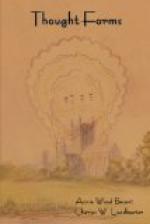[Illustration: FIG. 3. FORMS PRODUCED IN SOUND]
[Footnote 1: The Eidophone Voice Figures. Margaret Watts Hughes.]
[Footnote 2: Mr Joseph Gould, Stratford House, Nottingham, supplies the twin-elliptic pendulum by which these wonderful figures may be produced.]
The following description is taken from a most interesting essay entitled Vibration Figures, by F. Bligh Bond, F.R.I.B.A., who has drawn a number of remarkable figures by the use of pendulums. The pendulum is suspended on knife edges of hardened steel, and is free to swing only at right angles to the knife-edge suspension. Four such pendulums may be coupled in pairs, swinging at right angles to each other, by threads connecting the shafts of each pair of pendulums with the ends of a light but rigid lath, from the centre of which run other threads; these threads carry the united movements of each pair of pendulums to a light square of wood, suspended by a spring, and bearing a pen. The pen is thus controlled by the combined movement of the four pendulums, and this movement is registered on a drawing board by the pen. There is no limit, theoretically, to the number of pendulums that can be combined in this manner. The movements are rectilinear, but two rectilinear vibrations of equal amplitude acting at right angles to each other generate a circle if they alternate precisely, an ellipse if the alternations are less regular or the amplitudes unequal. A cyclic vibration may also be obtained from a pendulum free to swing in a rotary path. In these ways a most wonderful series of drawings have been obtained, and the similarity of these to some of the thought-forms is remarkable; they suffice to demonstrate how readily vibrations may be transformed into figures. Thus compare fig. 4 with fig. 12, the mother’s prayer; or fig. 5 with fig. 10; or fig. 6 with fig. 25, the serpent-like darting forms. Fig. 7 is added as an illustration of the complexity attainable. It seems to us a most marvellous thing that some of the drawings, made apparently at random by the use of this machine, should exactly correspond to higher types of thought-forms created in meditation. We are sure that a wealth of significance lies behind this fact, though it will need much further investigation before we can say certainly all that it means. But it must surely imply this much—that, if two forces on the physical plane bearing a certain ratio one to the other can draw a form which exactly corresponds to that produced on the mental plane by a complex thought, we may infer that that thought sets in motion on its own plane two forces which are in the same ratio one to the other. What these forces are and how they work remains to be seen; but if we are ever able to solve this problem, it is likely that it will open to us a new and exceedingly valuable field of knowledge.
[Illustration: FIGS. 4-7. FORMS PRODUCED BY PENDULUMS]




